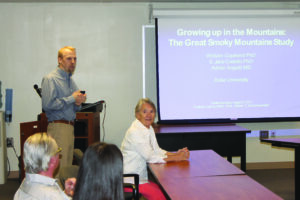By SCOTT MCKIE B.P.
ONE FEATHER STAFF
Researchers are finding out interesting things about youth growing up in the Smoky Mountains of western North Carolina. Three Duke University researchers gave an update presentation in Cherokee on Monday, Aug. 27 on their ongoing study entitled “Growing up in the Smokies: The Great Smoky Mountains Study”.

William Copeland (standing), Ph.D., begins an update presentation in Cherokee on Monday, Aug. 27 on the ongoing study entitled “Growing up in the Smokies: The Great Smoky Mountains Study”. (SCOTT MCKIE B.P./One Feather)
The study began in 1993 and has followed a total of 1,420 mountain youth for the past 20 years. The kids, as the researchers endearingly call them, started in the study at the age of 9, 11 or 13, and 350 of them are EBCI tribal members.
“It is most certainly not a study of kids anymore,” said William Copeland, Ph.D. who said the study includes kids from the 11 counties located west of Buncombe County. “We really wanted to get a sense of what was a representative group of kids from this area in 1993.”
Copeland was joined at Monday’s presentation by British husband-wife team of E. Jane Costello, Ph.D. and Adrian Angold, Ph.D. who started the study.
Trained interviewers met with the child and their parents to monitor behaviorial and emotional functioning as well as garner information about physical health, future plans, education, work/income and “derailments” such as substance use and abuse.
The kids were interviewed at the following ages: 9, 10, 11, 12, 13, 14, 15, 16, 19, 21, 25 and interviews have begun at 30. Over 80 percent were seen and interviewed successfully at each observation age.

Prior to Monday’s presentation, Principal Chief Michell Hicks (right) meets with GSMS researchers including Andrian Angold, Ph.D., William Copeland, Ph.D. and E. Jane Costello, Ph.D., as Vickie Bradley, EBCI Deputy Health Officer looks on.
One part of the study focuses on the relationship between childhood psychological disorders and adult psychological disorders. According to Copeland, 10-12 percent of the kids had a psychiatric diagnosis at age 13. That number jumped to 25 percent by the time the kids reached 21.
“Over 60 percent of the kids have met the criteria for a disorder by the time they reach adulthood.”
Obesity is another area of interest and concern for researchers. They checked mean BMI (body mass index) readings on the kids and found that the American Indian boys and girls in the study have much higher BMIs than their non-Indian counterparts.
Copeland said a BMI of 25 is considered overweight and one of 30 or higher is considered obese. The average rate of the American Indians over 21 in the study is over 30. Three out of four of the Indian girls and half of the Indian boys were classified as obese.
“Clearly, weight issues are a problem for each group, but it is especially true for the American Indian children,” he said.
He related that all of the Indian kids who had diabetes in the course of the study were in the chronically overweight group. Some risk factors for obesity for both Indians and non-Indians included: being a teen mother or a single mother, having parents with a history of mental illness, or poverty. Risk factors that seen to affect only Indian kids include: violence between parents, child being teased or bullied or the child has few friends.
Copeland pointed out that those risk factors were certainly not unique to the Indian kids, but that they were “disproportionately affected”.
The researchers related that the age 30 interviews are ongoing and future updates of this study will be forthcoming.


